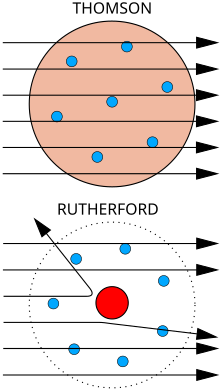
A fixed-target experiment in particle physics is an experiment in which a beam of accelerated particles is collided with a stationary target. The moving beam (also known as a projectile) consists of charged particles such as electrons or protons and is accelerated to relativistic speed. The fixed target can be a solid block or a liquid or a gaseous medium.[1][2] These experiments are distinct from the collider-type experiments in which two moving particle beams are accelerated and collided. The famous Rutherford gold foil experiment, performed between 1908 and 1913, was one of the first fixed-target experiments, in which the alpha particles were targeted at a thin gold foil.[1][3][4]
- ^ a b "The Particle Adventure | How do we experiment with tiny particles? | Fixed-target experiments". particleadventure.org. Retrieved 2021-07-16.
- ^ "Detectors, Fixed-Target | Encyclopedia.com". encyclopedia.com. Retrieved 2021-07-16.
- ^ "Fixed-target physics". ed.fnal.gov. Retrieved 2021-07-16.
- ^ "Fixed target, striking physics". CERN Courier. 2019-03-11. Retrieved 2021-07-21.